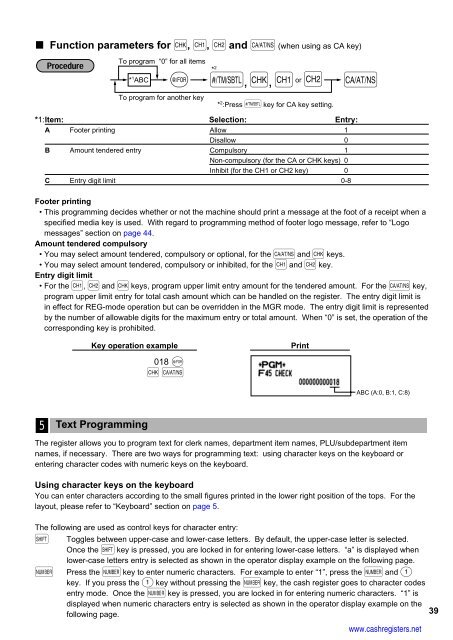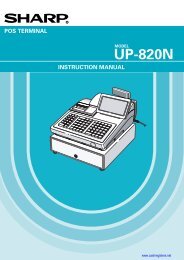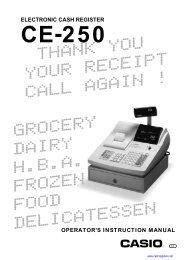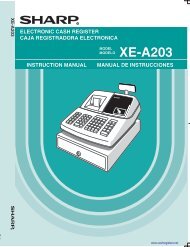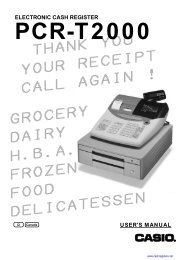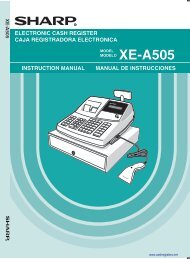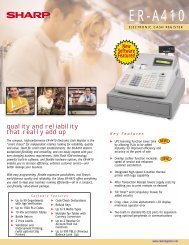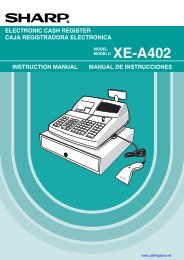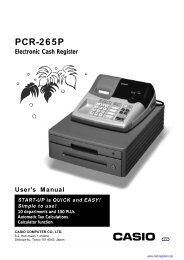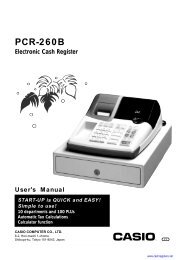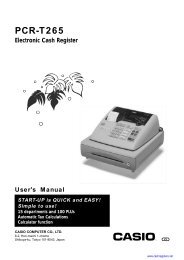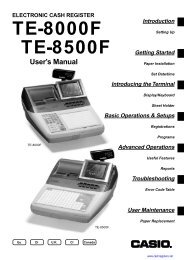1 - Cash Registers
1 - Cash Registers
1 - Cash Registers
You also want an ePaper? Increase the reach of your titles
YUMPU automatically turns print PDFs into web optimized ePapers that Google loves.
Function parameters for C, X, Y and A (when using as CA key)<br />
*1:Item: Selection: Entry:<br />
A Footer printing Allow 1<br />
Disallow 0<br />
B Amount tendered entry Compulsory 1<br />
Non-compulsory (for the CA or CHK keys) 0<br />
Inhibit (for the CH1 or CH2 key) 0<br />
C Entry digit limit 0-8<br />
Footer printing<br />
• This programming decides whether or not the machine should print a message at the foot of a receipt when a<br />
specified media key is used. With regard to programming method of footer logo message, refer to “Logo<br />
messages” section on page 44.<br />
Amount tendered compulsory<br />
• You may select amount tendered, compulsory or optional, for the A and C keys.<br />
• You may select amount tendered, compulsory or inhibited, for the X and Y key.<br />
Entry digit limit<br />
• For the X, Y and C keys, program upper limit entry amount for the tendered amount. For the A key,<br />
program upper limit entry for total cash amount which can be handled on the register. The entry digit limit is<br />
in effect for REG-mode operation but can be overridden in the MGR mode. The entry digit limit is represented<br />
by the number of allowable digits for the maximum entry or total amount. When “0” is set, the operation of the<br />
corresponding key is prohibited.<br />
5<br />
Text Programming<br />
To program “0” for all items<br />
* 1 *<br />
ABC or @ s, C, X A<br />
2<br />
To program for another key<br />
Key operation example<br />
018 @<br />
CA<br />
* 2 :Press s key for CA key setting.<br />
ABC (A:0, B:1, C:8)<br />
The register allows you to program text for clerk names, department item names, PLU/subdepartment item<br />
names, if necessary. There are two ways for programming text: using character keys on the keyboard or<br />
entering character codes with numeric keys on the keyboard.<br />
Using character keys on the keyboard<br />
You can enter characters according to the small figures printed in the lower right position of the tops. For the<br />
layout, please refer to “Keyboard” section on page 5.<br />
The following are used as control keys for character entry:<br />
H Toggles between upper-case and lower-case letters. By default, the upper-case letter is selected.<br />
Once the H key is pressed, you are locked in for entering lower-case letters. “a” is displayed when<br />
lower-case letters entry is selected as shown in the operator display example on the following page.<br />
N Press the N key to enter numeric characters. For example to enter “1”, press the N and 1<br />
key. If you press the 1 key without pressing the N key, the cash register goes to character codes<br />
entry mode. Once the N key is pressed, you are locked in for entering numeric characters. “1” is<br />
displayed when numeric characters entry is selected as shown in the operator display example on the<br />
following page.<br />
Print<br />
Y<br />
www.cashregisters.net<br />
39


